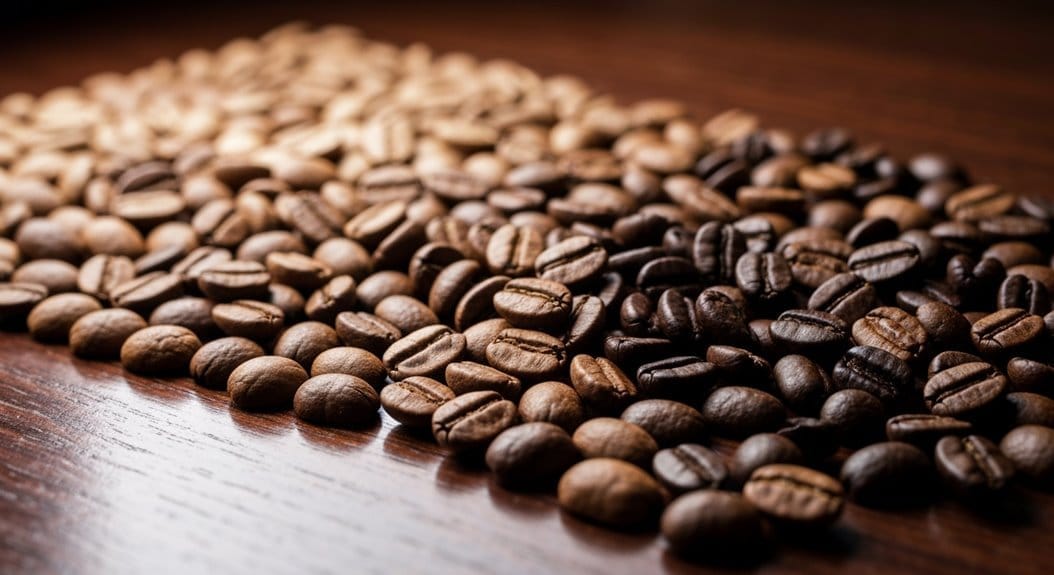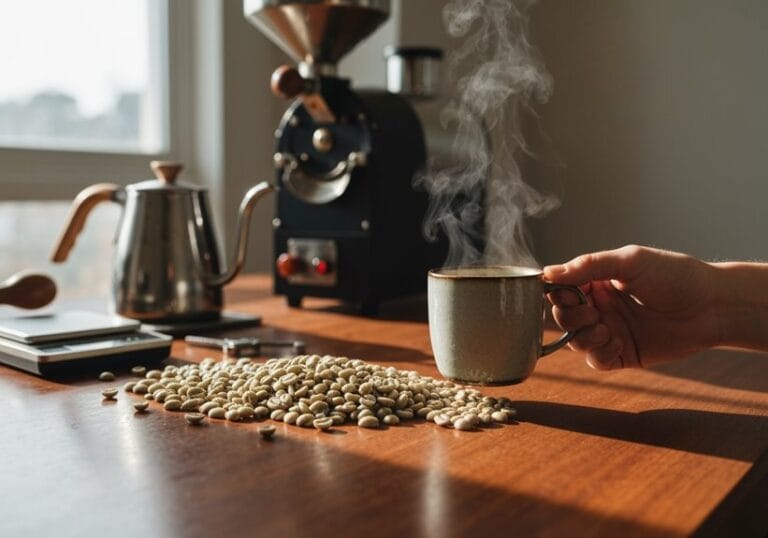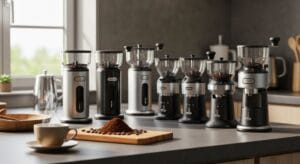When roasting coffee beans at home, you want to hit that sweet spot between 180°C and 250°C (yep, that’s 356°F to 482°F for those of you rocking Fahrenheit). Too low and your beans are like “meh,” too high and they’ll taste like burnt rubber — not exactly the morning perk you’re after! Aim for about 225°C for a solid 30 minutes to really release those flavors. Stick around, and you’ll unveil more roasting secrets to brew the ultimate cup!
Key Takeaways
- Aim for a roasting temperature between 180°C to 250°C to achieve desired flavors in coffee beans.
- For light roasts, maintain temperatures between 180°C to 205°C for bright, fruity profiles.
- Medium roasts benefit from temperatures between 210°C to 220°C, offering balanced flavors.
- Dark roasts require temperatures above 220°C to develop bold, smoky characteristics.
- Always preheat your roaster and monitor temperatures closely with a probe thermometer for consistent results.
Ideal Roasting Temperature Range
Regarding roasting coffee beans at home, many folks might be surprised to learn that hitting the ideal temperature range can feel like walking a tightrope—except the tightrope is made of freshly roasted beans (which is just the kind of balancing act coffee lovers dream about!).
To get that perfect cup, most home roasters aim for between 180°C and 250°C (or 356°F to 482°F). Light roasts hover around 180°C to 205°C, keeping those bright flavors alive, while medium roasts land between 210°C and 220°C, creating a nice balance. Higher temperatures can enhance the extraction of delicate flavors in light roasts, ensuring you capture their full essence.
Then, for those dark, smoky delights? You’ll need to crank it up over 220°C! Mastering these temperature variations is key for roasting consistency, turning those green beans into liquid gold!
Impact of Roasting Time on Flavor
Roasting coffee beans at home isn’t just a casual hobby; it’s a thrilling adventure where timing is everything! Who knew a couple of minutes could mean the difference between heavenly coffee and a bitter disaster?
It’s all about flavor evolution—if you roast too long, you’re faced with that nasty bitterness! But don’t rush it, either; under-roasting leaves you with muted flavors, like a rock concert with no band.
Finding roast consistency can feel like searching for a unicorn—rare but magical! Studies show that a sweet spot might be roasting at 225°C for 30 minutes, balancing complex flavors with body. Remember that the development stage is crucial in determining the final roast profile.
Relationship Between Roast Level and Color

When talking about roast levels, it’s like peeling back the layers of an onion—except this onion smells amazing and you definitely won’t cry while making your morning brew! The relationship between roast color and flavor profile is essential for coffee lovers.
Exploring roast levels is a delightful journey, revealing how color transforms into irresistible coffee flavors.
- Light roasts: bright, floral, and fruity
- Medium roasts: balanced, introducing caramel and nutty notes
- Medium-dark roasts: richness intensifies with deeper flavors
- Dark roasts: bold, bitter, and sometimes chocolatey
As the coffee beans dance through the temperatures, their color shifts dramatically, revealing how flavor develops.
Lighter colors maintain the bean’s original identity, while darker hues can overshadow those delightful, unique traits.
Who knew color could taste so good?
Effects of High Temperatures on Coffee Quality
For those who might think high temperatures only belong in the oven for baking goodies, consider again! Roasting coffee beans at higher temps can feel like playing with fire—literally!
When the heat gets cranked up, the acidity dynamics in coffee beans change. We’re talking about those zingy flavors that can turn into a sour mess or, if you’re lucky, a tangy delight.
Imagine this: too much heat, and you risk bitter, burnt flavors fighting your taste buds like they’re at war!
But don’t freak out! Properly controlled high temps can actually enhance those delicious sensory attributes and aromatic complexities.
Practical Tips for Home Roasting

Ah, the art and chaos of home coffee roasting! It’s a wild ride, folks, and it’s easy to stumble—like when you forget to preheat your roaster. You want roast consistency, right?
The thrilling journey of home coffee roasting can be chaotic, especially if you forget that crucial preheat!
Here are some survival tips for your coffee-dreams:
- Preheat your roaster to keep temperature regulation in check.
- Use a probe thermometer for accurate readings; ambient temps can lie!
- Start slow—doggone it, don’t go from zero to “burnt” in five moments!
- Take notes, because forgetting a killer roast profile is like losing a favorite recipe!
Frequently Asked Questions
Can I Reuse Coffee Grounds After Roasting?
Recycling coffee grounds after roasting can improve their flavor profile for certain uses, such as composting or gardening. However, they may lack ideal taste for brewing, limiting their reuse in coffee preparation.
How Do I Store Roasted Coffee Beans?
To store roasted coffee beans effectively, one should use airtight containers for the best storage solution. This minimizes air and moisture exposure, preserving beans’ freshness and flavor for ideal enjoyment over the coming weeks.
What Equipment Do I Need for Home Roasting?
For home roasting, essential equipment includes a roaster (drum or air), cooling tray, thermometer, and scales. These tools facilitate different roasting techniques, ensuring quality control and consistency while capturing desired flavor profiles.
Can I Roast Coffee on a Stovetop?
Yes, one can roast coffee on a stovetop using stovetop methods. Maintaining proper heat control is essential during the process to prevent scorching and achieve an even roast, ensuring a satisfying coffee experience.
How Does Bean Origin Affect Roasting Temperature?
Bean origin greatly influences roasting temperature since different bean varieties feature unique roast profiles. High-altitude beans require higher temperatures for ideal flavor, whereas low-altitude varieties often roast successfully at lower temperatures to prevent burning and improve sweetness.





